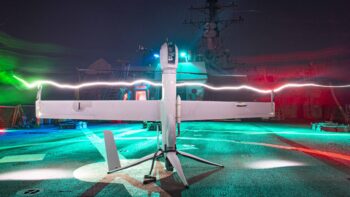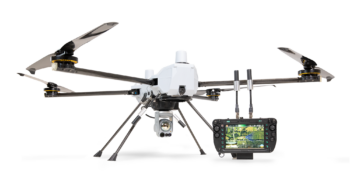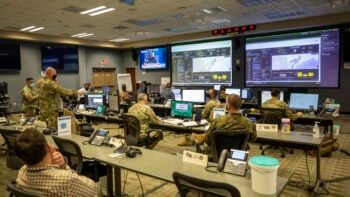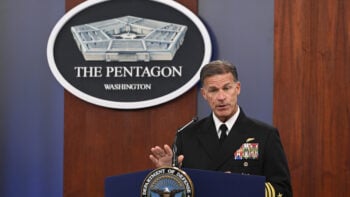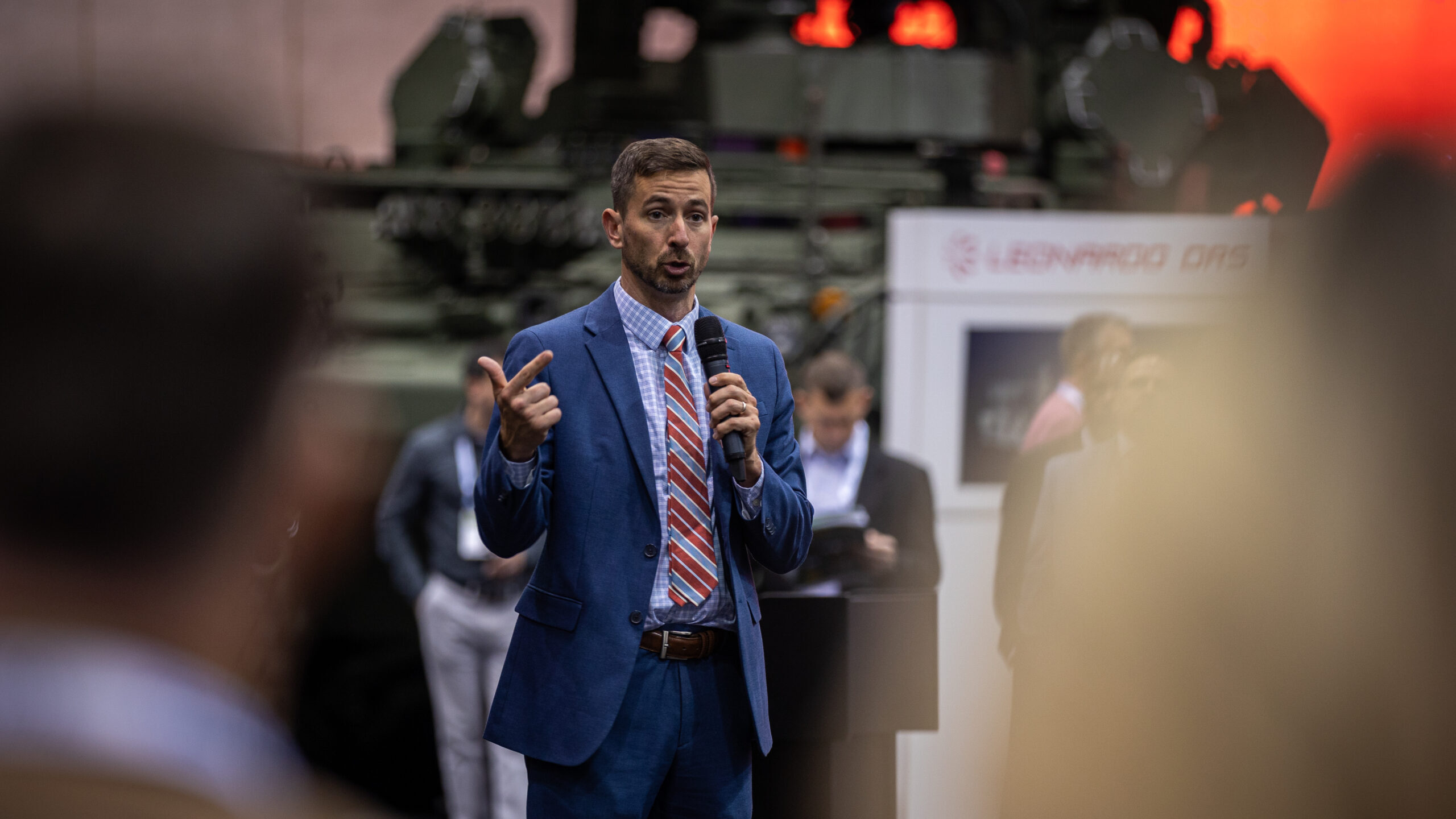
Mark Kitz, then-Program Executive Officer, Intelligence, Electronic Warfare and Sensors at the AUSA Global Force Symposium & Exposition 2023. (US Army Photo by Patrick Hunter)
WASHINGTON — Weeks into his new job leading the Army’s network modernization hub, Mark Kitz is thinking about ways to diversify the service’s investments to deliver a more flexible infrastructure to units, while also assessing how emerging technologies like artificial intelligence can help play a role in future operations.
Kitz, who took over the Army’s program executive office for command, control, communications-tactical (PEO C3T) earlier this year, is responsible for the Army’s massive modernization of its tactical and enterprise network and fielding advanced communications gear to warfighters. Prior to his current role, Kitz served as the program executive officer for intelligence, electronic warfare and sensors (IEW&S), the service’s main hub for developing and integrating sensors and sensor data.
“We’ve got a lot going on across this PEO,” Kitz told Breaking Defense in an interview last week. “I’m really, really humbled and honored to be a part of this team and I’m really looking forward to the future and defining the future of the network.”
Simplifying And Streamlining The Army’s Network
Kitz has already started identifying a few goals and objectives he hopes to accomplish in his new role, beginning with building off the momentum the PEO has had in delivering network capabilities to its units while developing options to deliver a network that is more “flexible.”
And while mapping out short, medium and long-term goals may be “slightly premature” (this is his third week on the job), PEO C3T has been “delivering significant” network, mission command and enterprise capabilities to the Army for a long time, Kitz said.
At the top of his priorities is “unifying” the Army’s network operations, an area which he said the service will work to deliver more next-generation capabilities with industry starting in fiscal 2024.
“In the midterm, I think there are real opportunities for our network and working with the Army senior leaders to identify those opportunities for us to deliver a more simple and streamlined network infrastructure, especially when it comes to our software solutions and especially when it comes to the density of capability that we’re delivering across a wide array of technologies, whether that’s in SATCOM or radios, or mission command applications,” he said.
“I think across our entire portfolio, there are opportunities for us to simplify and deliver capabilities that allow for our units to have a more flexible network infrastructure,” Kitz continued. That could look like a network that is easier to set up and delivering more commercial-based technology, he added.
A more long-term goal for Kitz is diversifying investment across the PEO to “allow the Army of 2020 [to] evolve to the Army of 2030 and so on.” He’s also assessing next-generation technologies for mission command applications and working with industry on how the Army handles and aggregates data across the battle space — things like how it delivers the right data to the right consumers and how the service leverages commercial investment and non-commercial investment in cloud technologies, he said.
One particular emerging tech area the Army is looking at is AI and machine learning (ML), and while Kitz said every PEO in the service has opportunities to work with both, he’s still figuring out exactly how C3T can best apply them.
“My last PEO, we established what was called Project Linchpin, which was meant to serve as our AI and ML expertise and infrastructure,” he said. “I think I plan to leverage that concept at C3T that we initiated at IEW&S, and so I would say I’m still evaluating how much we’ll be able to leverage those two technologies, but it is absolutely an opportunity for this PEO, whether it’s network path diversity, whether it’s how we deliver data aggregation and data to our mission command applications are all opportunities for AI [and] ML that we’re going to plan to try to leverage at C3T.”
The Army is planning to start awarding contracts for Project Linchpin, a relatively new effort aimed at developing the service’s AI and ML operations “environment” for its IEW&S systems, in FY24. In May, Kitz, in his former role as PEO IEW&S, said at an industry technical exchange meeting that he was weary about the scope of the effort.
“The ambition of [Project] Linchpin makes me nervous,” Kitz said then. “We can’t answer all of our AI/ML ops questions with the initial iteration of Linchpin… We’ve got to scope Linchpin around specific areas, specific problems sets, specific datasets…This is not the AI/ML ops pipeline in FY24 for all of Army datasets.”
More broadly, Kitz said he’s focused on delivering proven technologies on a more continuous basis to units after the Army recently decided to do away with its “capability sets” — packages of advanced battlefield tech being delivered in two-year increments.
“This narrative that we were only updating units on a yearly basis for capability sets I think was a challenge for the Army,” Kitz said. “We’re always going to integrate how we field and deliver capability to these units. What we’re really focusing on now is how do we get more flexible and agile with the technologies that we deliver to the unit.”
According to Kitz, that will look like leveraging more modern software practices and continually touching fielded technologies to make sure they have the most up-to-date cybersecurity capabilities.
“You don’t want to touch a unit this year and then seven years later, go back to the unit and finally give them something new, right?” he said. “We want to be able to update their software as they go. We want to be able to update their hardware as they go without full-on replacing their entire network. And so this way, it gives commanders options in terms of their ability to modernize. And one of our big hopes here is that it helps to simplify the network in that it gives them options on the way they employ it.”
‘A Great Opportunity’: Army’s PEO restructure
Come October, PEO C3T will look a bit different as it inherits several organizations from PEO enterprise information systems (EIS) as part of a broader restructuring across the Army’s network and cyber operations offices.
Among the biggest additions for PEO C3T is PEO EIS’s integrated enterprise network portfolio, enterprise-identity, credential and access management product office, and the allied information technology office.
Kitz said the reorganization is a “great opportunity for the Army to unify our approach to delivering the…network, whether that’s posts, camps, installations, how that integrates to our tactical environment, how the tactical environment then extends to our deployments.
“And so I think there’s just sort of this logical, you know, sort of enabler in having our enterprise and tactical capabilities more tightly integrated,” he continued. “I do want to add a little bit of…expectation management in…that synergy will take time as we learn sort of the uniqueness of the enterprise in the tactical space, but when it comes to things like network operations, when it comes to things like security and securing our environment, I think there are very clear and logical touch points between the two ways we’ve delivered the network of the past and building synergies in a more integrated network environment.”
Kitz said there are things he wants to take into his new job from his former role leading PEO IEW&S, specifically continuing an “open and honest dialogue” with industry partners where they can be involved early and often in program development.
“I want to make sure that I provide all the senior leaders options so that we can make important decisions on the technologies that we employ for modernizing and deploying our network,” he said. “And so those two things I definitely want to make sure I carry them, clearly tenants that I had at IEW&S, and I want to make sure that they carry in my time at C3T as well.”


















